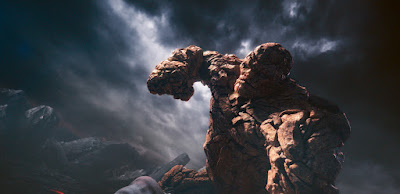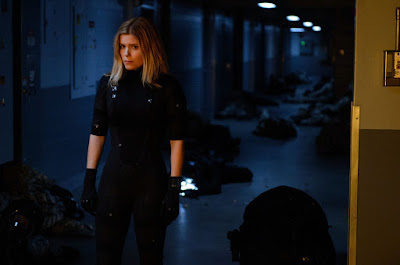I don't hate Tim Story's Fantastic Four films. Oh, don't get me wrong: they botch a lot of things (most notably Dr. Doom and Galactus) and apart from Chris Evans, they're mostly miscast. And yet, there are parts of those films I really liked. I liked seeing Johnny Storm go all Super Skrull in the second one (a flaming rocky fist at the end of a stretchy arm made me laugh out loud when I saw it). I liked The Silver Surfer, who was wonderfully well-realized. Story's films understand one important thing: the Fantastic Four ought to be fun, and that's a tone that his films strove for throughout. In some ways, they're out of step with the zeitgeist. They appeared right as the Christopher Nolan versions of grimdark superhero appeared, and their goofy naivete withers in comparison, at least in the fanboy massmind that equates grimdark with "realistic." They never really stood a chance in the marketplace of ideas.
The Fantastic Four are the bedrock of what became Marvel Comics and they deserve better than they've gotten from the movies. They certainly deserve better than Fox's new version of the characters. Fantastic Four (2015, directed by Josh Trank), which caves to the grimdark aesthetic. It's a glum film, shot in desaturated colors, fraught with angst and psychological theorizing. It's also occasionally incoherent, as if two separate movies had been stitched together in post-production, one a post-modern horror movie, the other a dumb superhero movie. It's an uneasy mixture, and tonally wrong almost from beginning to end.
The story follows boy genius Reed Richards. When we first meet him, he's presenting his ideas for what he wants to do when he grows up to his fifth grade class. He wants to build the first functioning teleport machine. His teacher scoffs at his ambition, but Reed is a genius and he's already built a prototype in his garage. He lacks only a power converter to make it work, This is provided by a trip to the local junkyard, where he meets Ben Grimm, his classmate, who wants to see what Reed is working on. The two become fast friends, and when they perfect their device and show it at the senior high school science fair years later, they come to the attention of Dr. Franklin Storm, whose Baxter Foundation is working on the same science. He invites Reed to his institute on a full scholarship. Reed's machine, it turns out, can bring things back from wherever it sends them, something that Storm's team has been seeking in vain. At the Baster Foundation, Reed is introduced to Victor Von Doom, whose work parallels his own. Von Doom is indifferent to Storm's project. He sees him as a corporate stooge, or worse, a dupe for the military. Reed also meets Storm's children: Sue, who is a scientist in her own right, and Johnny, whose gift for building things is being wasted as a street racer. Reed is the catalyst for the project and soon, the team is ready to send a team of explorers across the dimensional barrier. At this point, the project is taken from them by Dr. Allen, the weaselly corporate liaison to whom Storm reports. Rather than cede the glory of being the first to travel across the dimensional barrier, Reed, Victor, and Johnny vow to go themselves. People remember Neil Armstrong, Victor says, not the scientists who built the Saturn rockets. Reed vows to share the glory with Ben, and soon, the four of them power up the machine, and begin exploring. Unfortunately, the dimension next door has perils. A strange energy erupts from the landscape, claiming Victor, and almost destroying the dimensional shuttle and Reed, Johnny, and Ben in the bargain. Sue attempts to bring them back safely, but all four of them are caught in an explosion when the shuttle arrives back in the Baxter institute. All four of them have been affected by the experience, granted strange and uncontrolled powers. Dr. Allen sees in them a military potential and transports them to a secret base. Under the pretense of "helping" them, he grooms them as super soldiers. Reed will have none of this. He escapes to research a cure for himself and his friends on his own. Meanwhile, Dr. Allen compels Dr. Storm to recreate the dimensional shuttle, a fool's errand without Reed's genius. When, at last, Reed is recaptured by the military, he reluctantly agrees and the team that goes across the barrier comes back with what's left of Victor. Victor, for his part, has a grudge, and terrifying power...
This is a film with serious structural deficiencies. It gets itself tangled up with exposition such that it spends almost two thirds of its running time establishing its primary premises and conflicts. Worse, it's purely mechanical in how it goes about things. Its characters do things because they're supposed to do things rather than because their actions are motivated by who they are. Reed Richards is the ostensible protagonist of this film and the filmmakers have mistaken him for Harry Potter. I'll give the film its due, though: the scenes early in the film of Reed as a kid have a certain amount of charm. These scenes remind me a bit of the early parts of Joe Dante's Explorers. They have the same kind of goofy let's build a space ship kind of moxie. There's an actual sense of discovery in these scenes, and you can actually believe that that kid grows up to become the smartest man in the world. And yet...even in these scenes, there's a creeping cynicism. Ben Grim is depicted as a neglected child, abused by his older brother who comes after him with a baseball bat and a exclamation of "It's clobberin' time!" thus turning the character's signature catch-phrase into something quite a bit darker than what you find in the comics.
The early scenes of the young adult Reed and his introduction to the Baxter Foundation are reminiscent of Harry Potter's first trip to Hogwarts. Reed wanders around gawping. He's a point of view in these scenes rather than a character in his own right. There's no sense of him processing and analyzing what he sees. There's no spark of genius in his awkward first conversation with Sue Storm. The most compelling character in these scenes is Victor Von Doom, who seizes the spotlight away from Reed and Sue and Johnny. The movie hints that Reed and Victor are romantic rivals for Sue, but there's no heat between any of them. This is a flaw if the film wants to suggest that Doom and Reed's enmity derives from Reed and Sue winding up together, in part because the film never actually hints that Reed and Sue ever actually wind up together. That's just assumed rather than shown and given the film's other liberties with the material, that's something that should have been made explicit. But it's not. Reed's behavior late in the film, when he vanishes and leaves his friends behind, is even more problematic. It paints him as a coward. It also leaves a gaping hole in the narrative, given that the movie has heretofore focused on Reed, and it doesn't invite any of the other characters to fill the void. Oh, Ben Grimm could fill the void, but during this part of the film, the only footage we get of him is at second hand. Sue could fill it, too, but she's not allowed to do anything more than stew in resentment. Johnny is mostly a special effect. The character who dominates this part of the film is Dr. Allen, one of the film's ostensible villains. It's a puzzling choice.
If anything, this film's long first act is an abject demonstration of the fact that film is not an actor's medium. This film's cast is terrific, and in anyone else's Fantastic Four film might sparkle. Indeed, Miles Teller, Kate Mara, Michael B. Jordan, Jamie Bell, Toby Kebbell, and Tim Blake Nelson all have solid resumes. You have actors this good, you give them something to do or sparkling dialogue to speak and let them carry the film for you if you're going to skimp on the spectacle (which this film ultimately does). This film does none of this. The actors in this film are placeholders.
The film's most effective passages are the depiction of the Fantastic Four's powers when they first return from "Planet Zero." These scenes are palpably terrifying. The shots of Johnny Storm burning alive are ghastly, as are the grotesque depiction of Reed's elongated limbs. Even Sue's invisibility is disturbing. Even more disturbing is this film's conception of Dr. Doom, who has been fused with his containment suit and stalks through the base causing Scanners-like head explosions. Doom, in this film, has more in common with Negative Zone villain Annihilus than he does with the Dr. Doom of the comics and I wish the film had chosen Annihilus unstead of Doom, given the way they've reimagined the team's origin, because this version of Doom is even farther afield than the Doom of the Story films. Doom's origins aren't hard to do. Hell, the best version of his origin is in The Revenge of the Sith, and if George Lucas can get it right, anybody can. Or so you would think. In any event, this film's nominal director, Josh Trank, had great success with his first film, Chronicle. Chronicle was a superhero film that played like a horror film. He brings that aesthetic to the Fantastic Four. You can see where he was going in these scenes before the film was taken away from him. Even so: while this aesthetic is the most effective thing in the film, it's completely wrong for the characters.
The climax, when it comes, comes up small. Because it takes place on Planet Zero, there's a de-emphasis on what the conflict means to the world at large. It's like it takes place in a private pocket universe where the only people who matter are Doom and Richards. While you can make a justification for this given the characters' histories, the film hasn't developed either of them to the point where the audience really cares. Instead, you get a light show and an occasional demonstration of the Fantastic Four's powers, something the film has been relatively shy about showing to best advantage. This is a film of unfulfilled promises. Hell, the showdown with Dr. Doom in the 2005 film at least showed the heroes discovering how to use their powers together in a way that makes sense. You get no such thing here.
Perhaps the scene that best demonstrates this film's patchwork production history comes at the very end, when our characters stumble over what to call themselves. In this scene alone is there a realization that "fun" is something that needs to attend these characters. Of course, they fumble this. It's almost a non-sequitur, an appendage tacked on to send the audience to the parking lot with the sense that they haven't just sat through a dire, visually dull, intellectually cynical exercise in separating them from their money.

I'm using Patreon as a means of funding my blogs. They don't have a widget yet, so this link will just have to do. If you like my writing and art and if you'd like to support Krell Laboratories and Christianne's Art and Comics, please come on over and pledge. Thanks.


















No comments:
Post a Comment